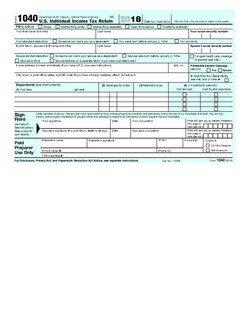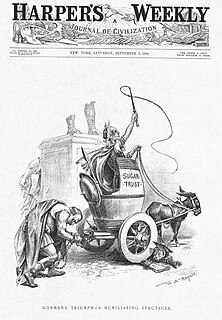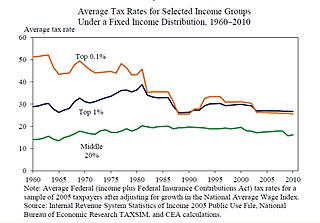Provisions
Section 116 of the Act imposed the tax on "the gains, profits, and income of every person residing in the United States, or of any citizen of the United States residing abroad, whether derived from any kind of property, rents, interest, dividends, or salaries, or from any profession, trade, employment, or vocation, carried on in the United States or elsewhere, or from any other source whatever [ . . . ]" [1]
The measure created a third tax bracket and increased taxes overall from the rates set in 1862. Tax brackets under the Act were as follows:
- 0%: under $600 (under US$ 14,000 in 2013 dollars, or the about the same as the average of $13,425 in combined personal exemption + standard deduction for single and married taxpayers in the year 2008)
- 5%: from $600 to $5,000 (from US$ 14,000 to US$ 116,667 in 2013 dollars)
- 7.5%: from $5,000 to $10,000 (from US$ 116,667 to US$ 233,333 in 2013 dollars)
- 10%: $10,000 and above (US$ 233,333 and above in 2013 dollars)
In addition to raising income tax rates, the act established stamp taxes on such items as matches and photographs.
This act was allowed to expire as the populace mainly viewed it as an emergency measure for war-time situations. The Act ultimately expired in 1873 in the face of increased deficit spending. Congress readdressed reform of the tax law in 1893, eventually passing the Wilson–Gorman Tariff Act of 1894.

Form 1040 is an IRS tax form used for personal federal income tax returns filed by United States residents. The form calculates the total taxable income of the taxpayer and determines how much is to be paid or refunded by the government.

Reaganomics, or Reaganism, refers to the neoliberal economic policies promoted by U.S. President Ronald Reagan during the 1980s. These policies are commonly associated with and characterized as supply-side economics, trickle-down economics, or voodoo economics by opponents, while Reagan and his advocates preferred to call it free-market economics.

The Revenue Act or Wilson-Gorman Tariff of 1894 slightly reduced the United States tariff rates from the numbers set in the 1890 McKinley tariff and imposed a 2% tax on income over $4,000. It is named for William L. Wilson, Representative from West Virginia, chair of the U.S. House Ways and Means Committee, and Senator Arthur P. Gorman of Maryland, both Democrats.

The Economic Recovery Tax Act of 1981 (ERTA), or Kemp-Roth Tax Cut, was an Act that introduced a major tax cut, which was designed to encourage economic growth. The federal law enacted by the 97th US Congress and signed into law by US President Ronald Reagan. The Accelerated Cost Recovery System (ACRS) was a major component of the Act and was amended in 1986 to become the Modified Accelerated Cost Recovery System (MACRS).
A progressive tax is a tax in which the tax rate increases as the taxable amount increases. The term progressive refers to the way the tax rate progresses from low to high, with the result that a taxpayer's average tax rate is less than the person's marginal tax rate. The term can be applied to individual taxes or to a tax system as a whole. Progressive taxes are imposed in an attempt to reduce the tax incidence of people with a lower ability to pay, as such taxes shift the incidence increasingly to those with a higher ability-to-pay. The opposite of a progressive tax is a regressive tax, such as a sales tax, where the poor pay a larger proportion of their income compared to the rich.
Tax brackets are the divisions at which tax rates change in a progressive tax system. Essentially, tax brackets are the cutoff values for taxable income—income past a certain point is taxed at a higher rate.
In a tax system, the tax rate is the ratio at which a business or person is taxed. There are several methods used to present a tax rate: statutory, average, marginal, and effective. These rates can also be presented using different definitions applied to a tax base: inclusive and exclusive.

Noah Haynes Swayne was an American jurist and politician. He was the first Republican appointed as a justice to the United States Supreme Court.
The Revenue Act of 1861, formally cited as Act of August 5, 1861, Chap. XLV, 12 Stat. 292, included the first U.S. Federal income tax statute. The Act, motivated by the need to fund the Civil War, imposed an income tax to be "levied, collected, and paid, upon the annual income of every person residing in the United States, whether such income is derived from any kind of property, or from any profession, trade, employment, or vocation carried on in the United States or elsewhere, or from any other source whatever [. .. .]" The tax imposed was a flat tax, with a rate of 3% on incomes above $800. The Revenue Act of 1861 was signed into law by Abraham Lincoln. This Act introduced Federal income tax as a flat rate tax.

The Revenue Act of 1913, also known as the Underwood Tariff or the Underwood-Simmons Act, re-established a federal income tax in the United States and substantially lowered tariff rates. The act was sponsored by Representative Oscar Underwood, passed by the 63rd United States Congress, and signed into law by President Woodrow Wilson.
The United States Revenue Act of 1978, Pub.L. 95–600, 92 Stat. 2763, enacted November 6, 1978, amended the Internal Revenue Code by reducing individual income taxes, increasing the personal exemption from $750 to $1,000, reducing corporate tax rates, increasing the standard deduction from $3,200 to $3,400, increasing the capital gains exclusion from 50 percent to 60 percent, and repealing the non-business exemption for state and local gasoline taxes.

The United States Revenue Act of 1924, also known as the Mellon tax bill cut federal tax rates and established the U.S. Board of Tax Appeals, which was later renamed the United States Tax Court in 1942. The bill was named after U.S. Secretary of the Treasury Andrew Mellon.
Income taxes in the United States are imposed by the federal, most states, and many local governments. The income taxes are determined by applying a tax rate, which may increase as income increases, to taxable income, which is the total income less allowable deductions. Income is broadly defined. Individuals and corporations are directly taxable, and estates and trusts may be taxable on undistributed income. Partnerships are not taxed, but their partners are taxed on their shares of partnership income. Residents and citizens are taxed on worldwide income, while nonresidents are taxed only on income within the jurisdiction. Several types of credits reduce tax, and some types of credits may exceed tax before credits. An alternative tax applies at the federal and some state levels.
Income tax in Australia is imposed by the federal government on the taxable income of individuals and corporations. State governments have not imposed income taxes since World War II. On individuals, income tax is levied at progressive rates, and at one of two rates for corporations. The income of partnerships and trusts is not taxed directly, but is taxed on its distribution to the partners or beneficiaries. Income tax is the most important source of revenue for government within the Australian taxation system. Income tax is collected on behalf of the federal government by the Australian Taxation Office.
The marriage penalty in the United States refers to the higher taxes required from some married couples with both partners earning income that would not be required by two otherwise identical single people with exactly the same incomes. There is also a marriage bonus that applies in other cases. Multiple factors are involved, but in general, in the current U.S. system, single-income married couples usually benefit from filing as a married couple, while dual-income married couples are often penalized. The percentage of couples affected has varied over the years, depending on shifts in tax rates.
The history of taxation in the USA begins with the colonial protest against British taxation policy in the 1760s, leading to the American Revolution. The independent nation collected taxes on imports ("tariffs"), whiskey, and on glass windows. States and localities collected poll taxes on voters and property taxes on land and commercial buildings. In addition, there were the state and federal excise taxes. State and federal inheritance taxes began after 1900, while the states began collecting sales taxes in the 1930s. The United States imposed income taxes briefly during the Civil War and the 1890s. In 1913, the 16th Amendment was ratified, permanently legalizing an income tax.
A rate schedule is a chart that helps United States taxpayers determine their federal income tax for a particular year. Another name for "rate schedule" is "rate table".
Springer v. United States, 102 U.S. 586 (1881), was a case in which the United States Supreme Court upheld the federal income tax imposed under the Revenue Act of 1864.

The Buffett Rule is part of a tax plan which would require millionaires and billionaires to pay the same tax rate as middle class families and working people. It was proposed by President Barack Obama in 2011. The tax plan proposed would apply a minimum tax rate of 30 percent on individuals making more than one million dollars a year. According to a White House official, the new tax rate would directly affect 0.3 percent of taxpayers.

Proposition 30, officially titled Temporary Taxes to Fund Education, is a California ballot measure that was decided by California voters at the statewide election on November 6, 2012. The initiative is a measure to increase taxes to prevent US$6 billion cuts to the education budget for California state schools. The measure was approved by California voters by a margin of 55 to 45 percent.








